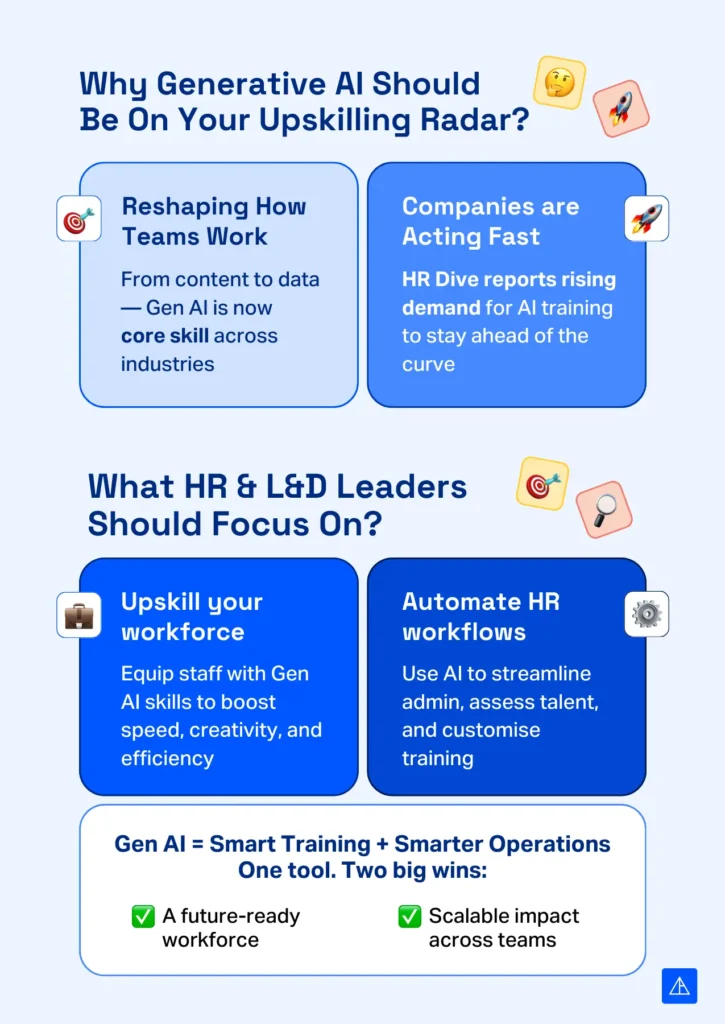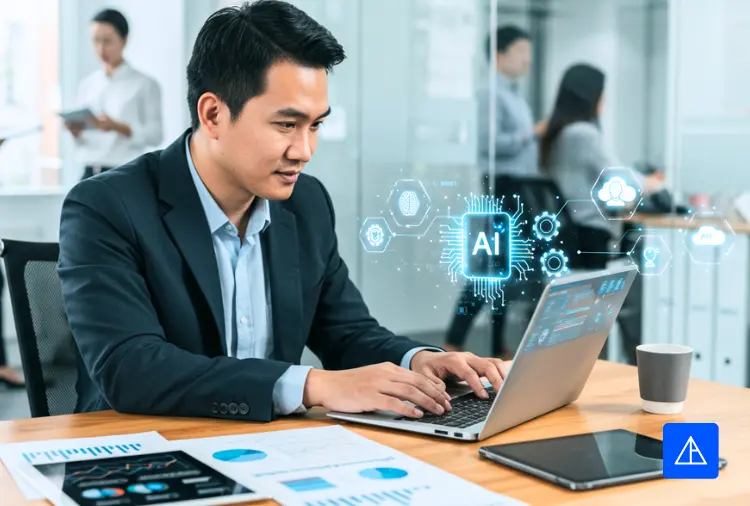In 2025, the rapid evolution of numerous job roles is surpassing workers’ ability to keep up.
According to HR Dive, a trusted source for workforce strategy and HR news, employers are struggling to find talent with the right skills. The gaps are especially clear in areas like artificial intelligence, cybersecurity, and data analysis.
This makes skills gap analysis more critical than ever. It’s a focused, data-driven way of identifying where employees’ skills fall short. HR and L&D teams can then roll out targeted training to close those gaps. Done well, it boosts performance, lifts retention, and keeps the workforce aligned with business goals.
This article explores how AI is transforming skills gap analysis and why generative AI should be part of every corporate upskilling plan.
Related Article: The Future Impact of AI: Preparing Your Workforce for What’s Next
What Is an AI-Powered Skills Gap Analysis?
Traditional skills reviews are slow, rigid, and based on outdated methods. They rely on static job descriptions, self-evaluations, or once-a-year reviews, often missing actual skill gaps.
AI-powered skills gap analysis offers a smarter approach. It uses algorithms and real-time data to give HR and L&D teams better visibility into workforce capabilities. Here’s what makes it different:
🔍 Live data analysis: AI scans job roles, internal performance metrics, and external labour trends to identify gaps as they emerge.
🎯 Personalised learning paths: It recommends training specific to each employee’s role and growth potential.
📈 Predictive insights: AI can forecast future skill demands based on business goals and market trends.
⚡ Faster, more accurate decisions: As noted by IBM, AI helps HR teams detect patterns in complex datasets that humans often overlook. This means fewer assumptions and more evidence-based planning.
Unlike static reports, AI systems keep evolving. They provide continuous feedback, allowing companies to adjust learning strategies as fast as the market shifts.
💡Discover how Gen AI fits your career — take the quick quiz now.
GENERATIVE AI QUIZ Unlock insights into how Generative AI can transform your career.
Related Article: How AI Trends Are Changing Corporate Learning – And How to Adapt
Why Generative AI Should Be on Your Upskilling Radar
Generative AI is already reshaping how teams across industries work. From content creation to data modelling, it’s becoming a must-have skill across roles.
As reported by HR Dive, companies are now prioritising AI-related training to stay ahead. Those who invest in these skills are better positioned to adapt, innovate, and retain top talent. For HR and L&D leaders, this shift creates two clear priorities:
- Upskill employees in generative AI tools: Staff who can use Gen AI become faster, more creative, and more efficient — whether in marketing, operations, or finance.
- Use AI inside HR processes: Automate repetitive admin, improve talent assessments, and personalise training at scale.
This dual impact makes Gen AI one of the most valuable skills to add to your learning roadmap as a training topic and an operational tool.
A structured course like the Vertical Institute Generative AI course offers a practical way to quickly get teams up to speed without distracting them from their day jobs.

📅 Don’t wait till the skills gap widens — enrol your team today.
Generative AI Course Boost efficiency and enhance productivity using Generative AI.
How Singapore Companies Are Using AI to Address Skills Gaps
Singaporean organisations are integrating AI to enhance workforce capabilities and address skills gaps. Here are some examples across various sectors:
Technology Firms
- Lenovo Singapore: Partnering with the Singapore Manufacturing Federation, Lenovo launched AI upskilling programs to equip workers with hands-on experience using AI tools in sectors like manufacturing and retail.
Finance and Banking
- DBS Bank: Singapore’s largest bank has initiated extensive employee upskilling programs, focusing on digital and AI capabilities to ensure readiness for future advancements.
Retail and Customer Service
- Grab: Grab heavily leverages AI for various functions, including route optimisation, personalised recommendations, fraud detection, and customer service automation across its platform.
Consulting and Professional Services
- IBM: IBM uses AI-powered tools like Watson to support strategic workforce planning. Their platform helps HR teams run “what-if” scenarios across hiring, compensation, and skill gap analysis, enabling smarter decisions about workforce needs.
Related Article: Top 5 Industries in Singapore Using Gen AI & How SMEs Can Upskill
Steps to Implement AI-Powered Skills Gap Analysis
Implementing AI-powered skills gap analysis involves several key steps:
1. Data Collection
Gather comprehensive data on employee skills, performance metrics, and industry benchmarks.
2. AI Integration
Utilise AI tools to analyse the collected data, identifying patterns and areas where skills are lacking.
Examples include:
- ChatGPT: Summarises survey feedback or performance reviews to spot repeated skill issues. Great for identifying communication or analytical skill gaps.
- GitHub Copilot (free for students and educators): Helps review code and suggest improvements, making it easier to assess programming proficiency.
- Google Gemini: Useful for analysing content portfolios or writing samples. It can highlight strengths and missing skills in content creation.
3. Training Development
Enrol employees in relevant AI upskilling programmes to address identified skill gaps. Many options for AI certification, from global online platforms to local training providers, make it easy to build job-ready skills at scale.
4. Continuous Monitoring
Regularly assess the effectiveness of training programs and update them as necessary to ensure alignment with evolving business needs.
👥 Upskill your team with expert guidance — book a free consultation today.

Book a Free Consultation
Discuss your career goals, decide which course is the best for you and understand the government subsidies.
FAQs About AI-Powered Skills Gap Analysis
Not at all. Many platforms are scalable and affordable, making them accessible for SMEs looking to improve training outcomes and workforce agility.
HR, L&D, team leaders, and department heads should collaborate to interpret AI-generated insights and align them with organisational goals.
Vertical Institute offers a structured Generative AI course for working professionals for corporate training needs. The programme runs 21 hours over 7 expert-led sessions (3 hours each) via Zoom. To explore enrolment options, connect with our admissions team.
Yes. The course focuses on practical applications of Gen AI in marketing, operations, HR, finance, and more. No coding background is required for most entry-level certifications.
SSG Subsidy: Singaporeans and Permanent Residents can receive up to 70% course fee support, depending on age and eligibility.
SFEC (SkillsFuture Enterprise Credit): Companies can claim additional subsidies for the remaining fees after SSG funding.
Absentee Payroll: Employers may receive funding support for employee wages during training.
Enterprise Innovation Scheme: This scheme offers a 400% tax deduction or a 20% cash payout based on net course fees.
Conclusion
Skills gap analysis has evolved from a simplistic HR function into a critical business strategy. With AI in the mix, it’s sharper, faster, and built for real-time decision-making.
Whether you’re exploring AI for the first time or already scaling internal training, one thing is clear — Generative AI is emerging as a core skill across functions, from operations to strategy.



